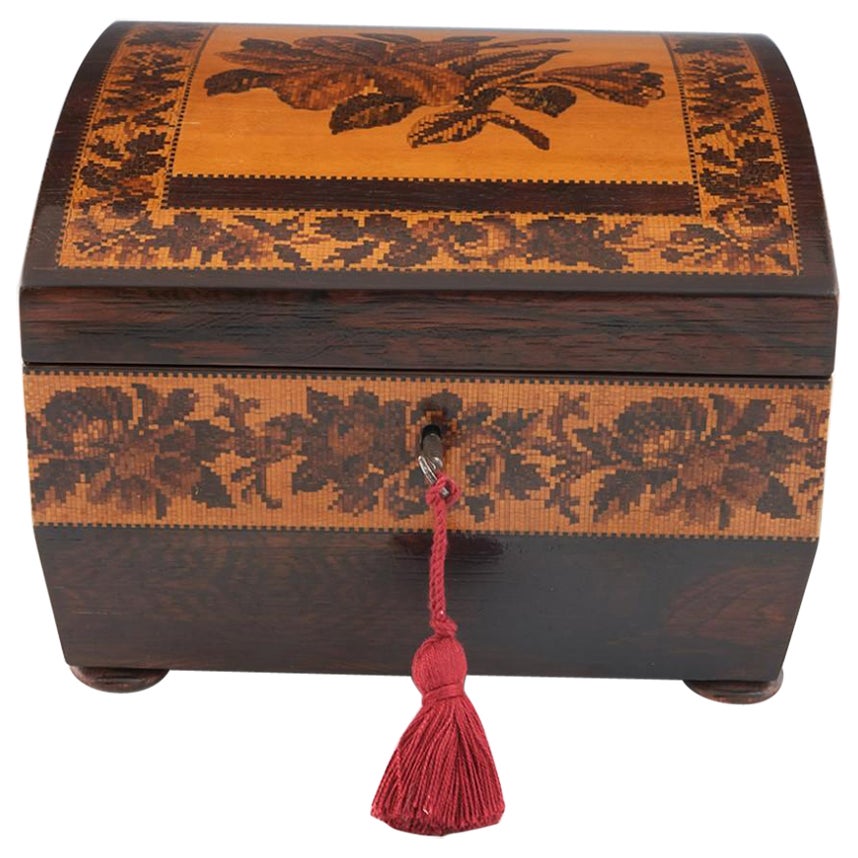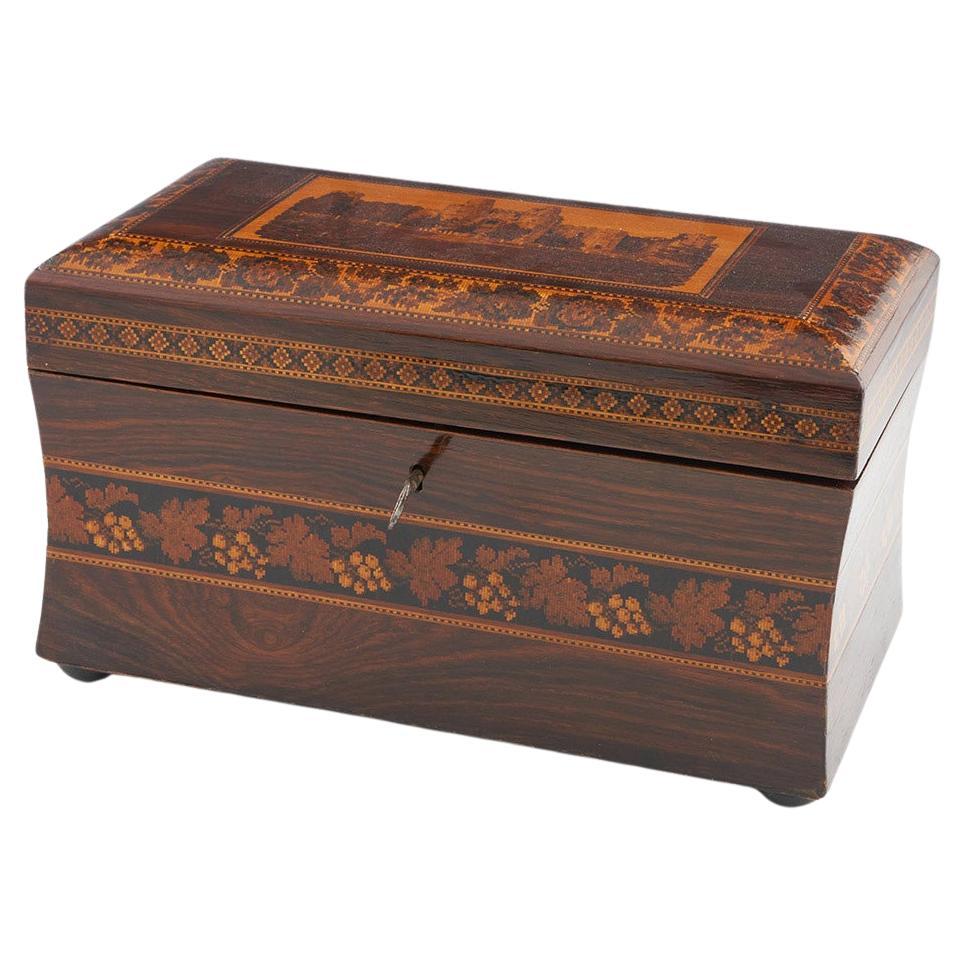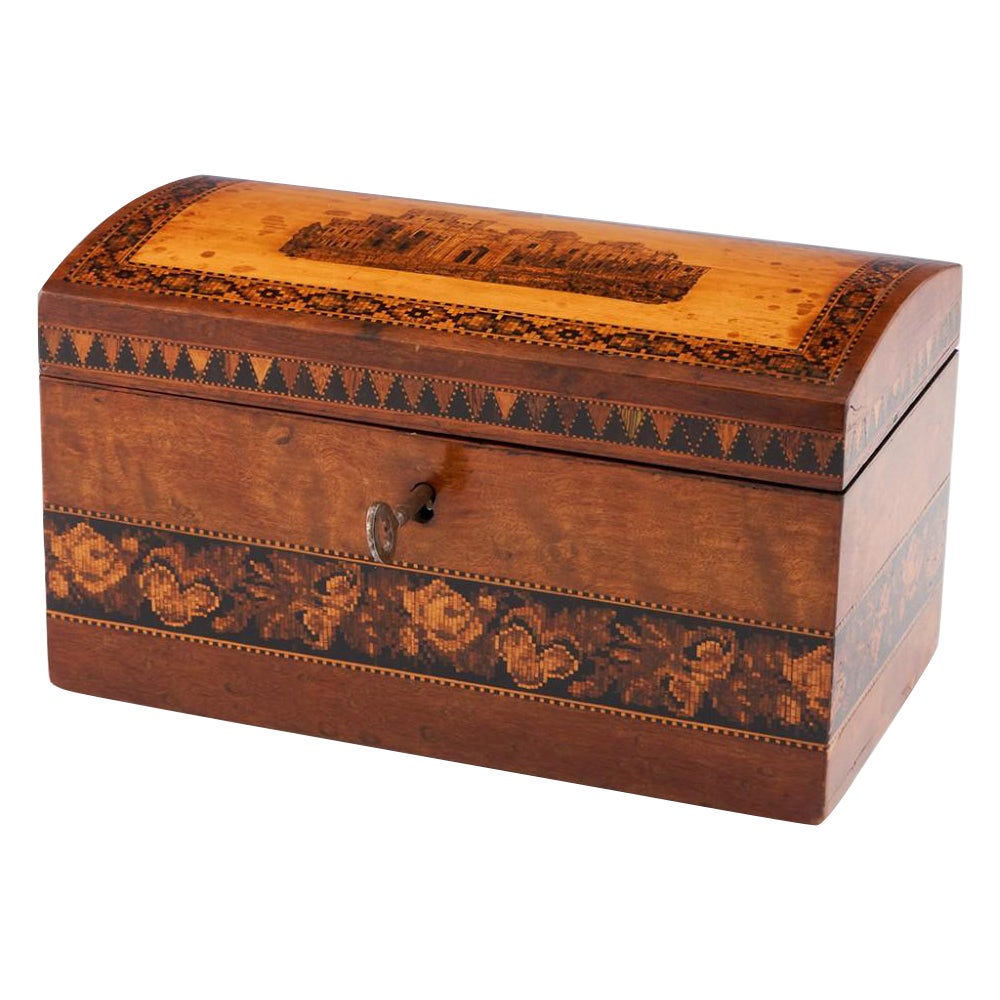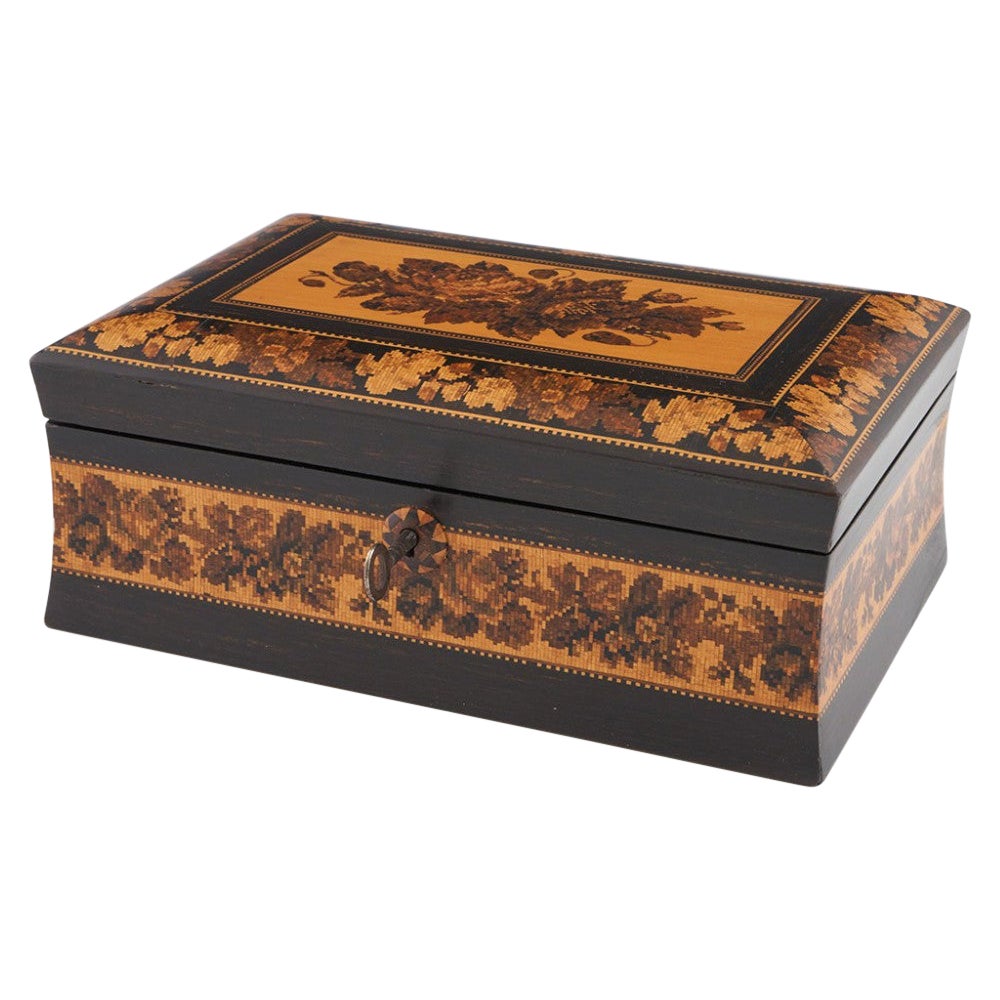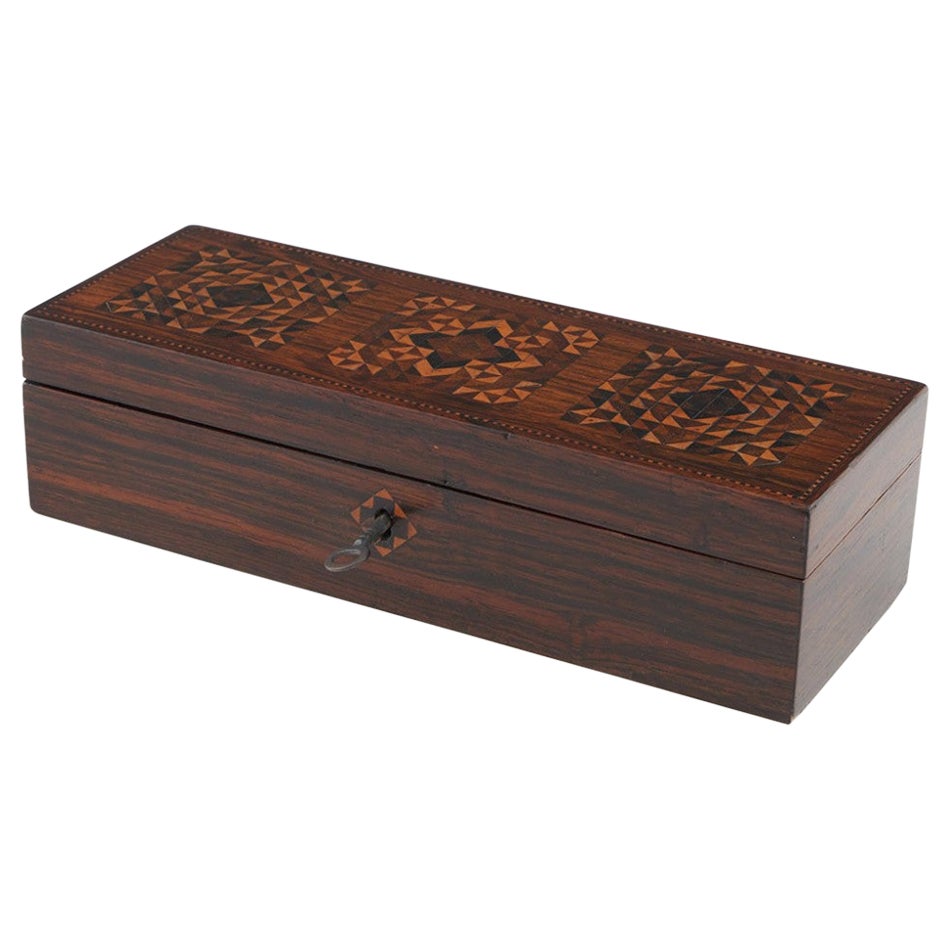Items Similar to Tunbridge Ware Games Box Depicting Bayham Abbey c1865
Want more images or videos?
Request additional images or videos from the seller
Tunbridge Ware Games Box Depicting Bayham Abbey c1865
About the Item
Heading : Tunbridge ware games box depicting Bayham Abbey
Date : c1865
Period : Victoria
Origin : Tunbridge Wells, Kent
Decoration : Central mosaic image of the ruins of Bayham Abbey within keylines; this is bordered by a berlin woolwork oak leaf pattern which is also within keylines. The side panels are decorated with fruiting vine berlin woolwork banding. The box contains the rules of Bridge, a cribbage board with six white and two black pegs together with two wooden whist markers
Size : 27.5x22.3x8.5cm
Condition : Good, there is some lifting to the central image, one significant line traverses the image around 2/3 of the way up. Otherwise just general light wear, the image and the woolwork patterns are all crisp and clear
Restoration : The central image has been stabilised. The whole box has been profesionally cleaned and polished
Weight : 1001 grams
The image is originally by Henry Hollamby. We know, however, that Thomas Barton and Edmund Nye also used Hollamby's version and, while we suspect this is probably a Hollamby original, it might be the work of the Nye / Barton partnership.
- Creator:Tunbridge Ware (Maker)
- Dimensions:Height: 3.35 in (8.5 cm)Width: 10.83 in (27.5 cm)Depth: 8.78 in (22.3 cm)
- Style:Victorian (Of the Period)
- Materials and Techniques:
- Place of Origin:
- Period:
- Date of Manufacture:1865
- Condition:Wear consistent with age and use.
- Seller Location:Tunbridge Wells, GB
- Reference Number:
About the Seller
5.0
Gold Seller
These expertly vetted sellers are highly rated and consistently exceed customer expectations.
Established in 2014
1stDibs seller since 2023
35 sales on 1stDibs
Typical response time: 4 hours
- ShippingRetrieving quote...Ships From: Tunbridge Wells, United Kingdom
- Return PolicyA return for this item may be initiated within 30 days of delivery.
More From This SellerView All
- Tunbridge Ware Trinket Box with Floral Mosaics, c1865By Henry HollambyLocated in Tunbridge Wells, GBTunbridge Ware Trinket Box with Floral Mosaics, c1865 Additional Information: Heading: Tunbridge Ware Trinket Box with Floral Mosaics c1865 Date : c1865 Period : Victorian Origin : ...Category
Antique 19th Century English Victorian Decorative Boxes
MaterialsSatinwood
- Tunbridge Ware Pillow-topped Glove Box Box with Floral Mosaic, c1865Located in Tunbridge Wells, GBTunbridge Ware Pillow-topped Glove Box Box with Floral Mosaic, c1865 Additional Information: Heading: A Tunbridge Ware Pillow-topped Glove Box Box with Floral Mosaic Date : c1865 Period : Victoria Origin : Tunbridge Wells, Kent Decoration : A low pillow-like lid with a mosaic of flowers from Golden Satinwood, within two pairs of banded and plain keylines and narrow floral pattern band. A further floral design to the sides, again within a pair of keylines Size : 25.6 W x 10.0 D x 8.5 H cm Condition : Excellent Condition - Key present, lock not working...Category
Antique 19th Century English Victorian Decorative Boxes
MaterialsSatinwood
- Tunbridge Ware Tea Caddy with Herstmonceux Caslte c1865By Henry HollambyLocated in Tunbridge Wells, GBHeading : Tunbridge ware tea caddy featuring image of Herstmonceux Castle Date : c1865 Period : Victorian Origin : Tunbrige Wells, Kent Decoration : Central mosaic depicting Herstmo...Category
Antique Mid-19th Century English Victorian Tea Caddies
MaterialsWood
- Tunbridge Ware - A Two Compartment Tea Caddy with Eridge Castle Mosaic, c1865Located in Tunbridge Wells, GBTunbridge Ware - A Two Compartment Tea Caddy with Eridge Castle Mosaic, c1865 Additional Information: Heading: Tunbridge Ware - A Two Compartment Tea Caddy with Eridge Castle Mosaic...Category
Antique 19th Century English Victorian Tea Caddies
MaterialsSatinwood
- Tunbridge Ware Jewellery Box c1870By Tunbridge WareLocated in Tunbridge Wells, GBHeading : Tunbridge ware jewellery box Date : c1870 Period : Victoria Origin : Tunbridge Wells, Kent Decoration : Pillow top cover with central floral mosaic within keylines. Cover b...Category
Antique 1870s British Victorian Decorative Boxes
MaterialsWood
- Tunbridge Ware Glove Box c1840By Tunbridge WareLocated in Tunbridge Wells, GBHeading : Tunbridge ware glove box Date : c1840 Period : Victoria Origin : Tunbridge Wells, Kent Decoration : Three geometric stickware designs to cover with keyline border. Internal...Category
Antique 1840s British Early Victorian Decorative Boxes
MaterialsWood
You May Also Like
- Regency Tunbridge Ware Sewing BoxBy Tunbridge WareLocated in Northampton, GBFitted Interior & Silver Handles From our Tunbridge Ware collection, we are delighted to offer this Tunbridge Ware Sewing Box. The Sewing Bo...Category
Antique Early 19th Century British Regency Decorative Boxes
MaterialsSatinwood
- Georgian Tunbridge Ware Folk Art Cottage Sewing BoxBy Tunbridge WareLocated in Northampton, GBTunbridge Ware Folk House Sewing Box From our Sewing Box collection, we are thrilled to offer this Novelty Folk Art Cottage Sewing Box. The box of rectangular form made from Sycamor...Category
Antique Early 1800s British Georgian Decorative Boxes
MaterialsWood, Sycamore
- Tunbridge Ware BoxLocated in Dallas, TXLarge Tunbridge ware box with herringbone pattern inlaid parquetry. Circa 1840, England.Category
Antique 1840s English Decorative Boxes
MaterialsWood
- Brighton Pavilion Tunbridge Ware Sewing CompendiumBy Tunbridge WareLocated in Northampton, GBRare Tunbridge Ware Form Sewing Compendium From our Tunbridge Ware collection, we are delighted to offer this very rare Tunbridge Wear Sewing Compendium. The Sewing Compendium modelled as a tower from the Brighton Pavilion features the iconic minaret turned in Sycamore (aka white wood) and a large globular body with hand-painted details leading to further turned faces and the hand-painted windows upon a stepped base. The Sewing Compendium opens in two locations one just below the first dome revealing a pin cushion and the second just above the windows revealing the Sewing tools including a Tunbridge Ware thimble and bobbin. The Tunbridge Ware Sewing Compendium dates to the Georgian era during the reign of George IV circa 1825. Brighton Pavilion, The Royal Pavilion and surrounding gardens are a Grade I listed property and were the former Royal residence located in Brighton, England. It was built in 1787 in three stages as a seaside retreat for George, Prince of Wales who became the Prince Regent in 1811 and then King George IV in 1820. It is built in the Indo-Saracenic style prevalent in India for most of the 19th century. The current appearance of the Pavilion which has various domes and minarets, is the work of architect John Nash, who extended the building starting in 1815. George IV's successors William IV and Victoria also used the Pavilion but Queen Victoria decided that Osborne House should replace the Pavilion as the royal seaside retreat and therefore the Pavilion was sold to the city of Brighton in 1850. Indo-Sarascenic refers to a cross between Indian architecture and Muslim architecture. Minarets means beacon in Arabic. In Islamic religious architecture, the tower from which the faithful are called to prayer five times each day by a muezzin, or crier. Such a tower is connected to a mosque and has one or more balconies or open galleries. The inspiration for the minarets features on the Brighton Pavilion are in homage to these types of finials. John Nash (1752-1835) was one of the most prevalent British architects from the Georgian and Regency periods. He was responsible for the design, in the neoclassical and picturesque styles of many important areas of London. He was financed by the Prince Regent and by the era's most successful property developer, James Burton. Nash's most famous designs were the Brighton Pavilion, Marble Arch and Buckingham Palace. Sycamore is a member of the Maple family, found in Europe. It is light yellow in colour and is often a very clean wood, with a straight, fine grain. The wood is often pippy. However, these pips are usually a very similar colour to the rest of the wood making them hardly visible. Georgian, a period in British history dating from 1714-1837, the Georgian era after the Hanoverian kings George I, George II, George III and George IV. Tunbridge Ware Tunbridge Wells and Tunbridge in Kent, England became popular in the 17th Century for their therapeutic waters. By the 18th century, Tunbridge Wells was a hugely popular Spa resort. Shops and stalls were set up to sell local work of distinction to visitors as souvenirs. Many of the original boxes were decorated with all sorts of different kinds of designs. Many of the Tunbridge boxes...Category
Antique Early 19th Century British George IV Decorative Boxes
MaterialsWood, Sycamore
- 19th Century British Tunbridge Ware Lap DeskBy Tunbridge WareLocated in Dallas, TXPresenting an absolutely gorgeous and extremely unique and rare 19th Century British Tunbridge ware lap desk. This lap desk is unlike any of it’s kind we have seen before. From cir...Category
Antique Mid-19th Century English High Victorian Decorative Boxes
MaterialsMaple, Walnut, Satinwood, Ebony, Wood
- Tunbridge Box Still Bank, circa 1870sBy Tunbridge WareLocated in Incline Village, NVThis Tunbridge box still bank is indigenous to the Tunbridge ware cottage industries of the town of Tunbridge Wells, Kent, England in the 18th and 19th c...Category
Antique 1870s English Victorian Decorative Boxes
MaterialsWood
Recently Viewed
View AllMore Ways To Browse
Louis Xiv Box
Travel Dressing Table
Japanese Puzzle Box Wood
Tiger Wood Bedroom Sets
Blue Marble Box
Copper Box
Elgin American Cigarette Case
Vintage Treen
Abalone Mexico Box
Antique French Chocolate Box
Chinoiserie Trinket Box
Penshell Box
Regency Sewing Box
Tessellated Horn Box
Antique Calling Card Case
Antique Calling Card Cases
Antique Sewing Box On Stand
Art Deco Chocolate Box
